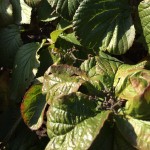A member of the Asteraceae family: Frosty Igloo
Found in the Chadwick Arboretum by Kottman Hall. I identified this plant as part of the Asteraceae family because it has head inflorescence and fused bracts called phylleries.
A member of the Poaceae family: Korean feather reed grass
Found in the Chadwick Arboretum by Kottman Hall. I identified this plant as a member of the Poaceae family because it had sheathed leaves, and a flower organized in a spike inflorescence with a pair of bracts on each spikelet.
Sight Identification: Lonicera spp.
Found on the Olentangy Bike trail near the Lane Ave. bridge. I identified this as a bush honeysuckle because it had opposite leaves, red berries in four clumps, and a hollow stem.
Sight Identification: Rosa multiflora
Found in the Glen Echo ravine along the trail by the fourth street entrance. I identified this as multiflora rose because of its general form: a multi-stemmed shrub with arching stems and thorns. I forgot to get a picture of this character, but it also had “eyelashes” on the stipules.
Produces berries: Viburnum dilatatum
Found in the Chadwick Arboretum near Kottman Hall. This species of Viburnum had structures were you could see where the fruit had attached. Berries are simple fruit that have fleshly inner and outer ovary walls. In other words, they are fleshy and soft all the way through.
Produces an umbel: Milkweed
Found in the Chadwick Arboretum near Kottman Hall. This species of milkweed is a perfect example of umbel inflorescence. An umbel is when each individual flower in a cluster comes from a single point at the top of a stem.






Good identification of a member of the Poaceae family, I actually had a mix up with one of these plants and thinking it was a sedge. So good job knowing the characteristics that define it.